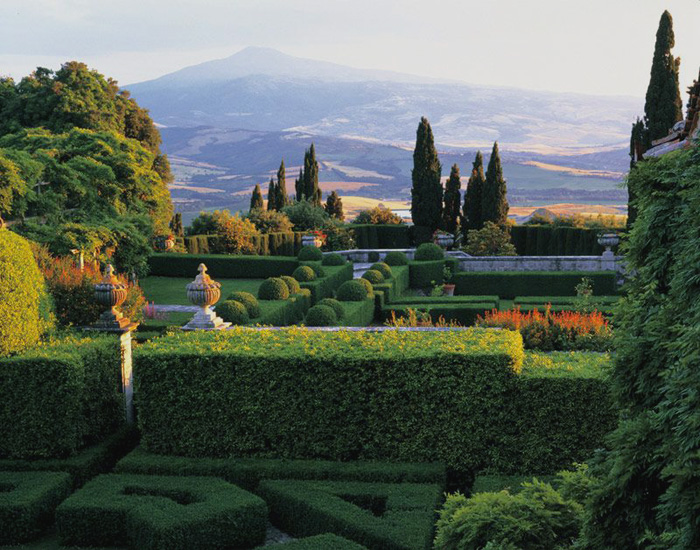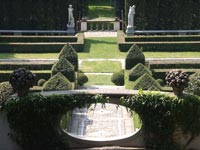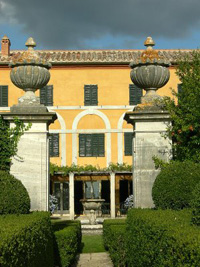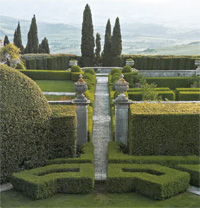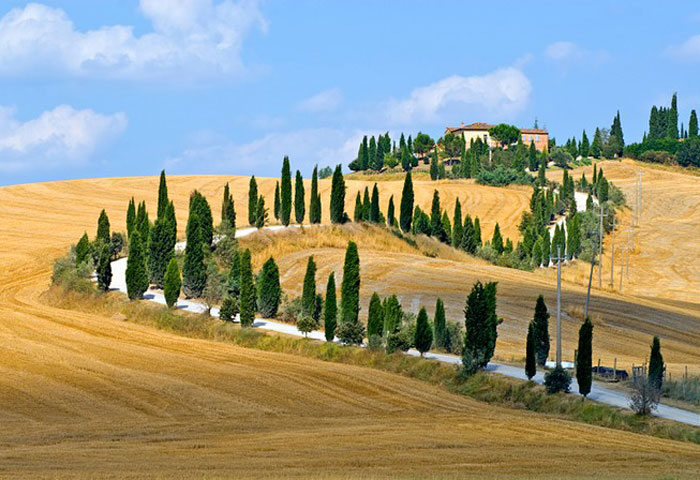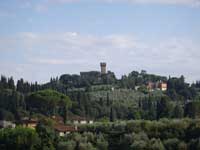Cecil Ross Pinsent |
Cecil Ross Pinsent (1884 May 5 - 5 December 1963) was a British garden designer and architect, noted for the innovative gardens which he designed in Tuscany between 1909 and 1939. These imaginatively re-visited the concepts of Italian 16th-century designers. |
|
||
Villa i Tatti in Settignano |
||
| Up above Florence, not far from Fiesole and Settignano, is the picturesque Villa I Tatti, formerly owned by Bernard and Mary Berenson, and now the Harvard Center for Italian Renaissance Studies. After Berenson had completed his undergrad studies at Harvard he moved to Italy, intending to be a writer. In 1900, he and Mary were wed and moved into the rented villa with its mysterious name shortly thereafter, which they then bought in 1905. Mary, with architect Cecil Ross Pincent, designed spectacular gardens, including a secret garden and another hanging garden, in the spirit of Italian Renaissance gardens, such as the Boboli Gardens behind the Pitti Palace in Florence. 'In 1900, when the death of her first husband allowed Berenson to marry Mary Costello, he rented a rural farmhouse known as I Tatti, which was named after an earlier owner called Zatti. Perched on a hillside just below Settignano and flanked by cypresses and a few lemon trees, I Tatti was much more humble than its inhabitants, and in 1907 when Berenson's growing fortune enabled him to purchase the villa, Mary immediately set about creating a setting worthy of her illustrious husband. She hired a young English architect, Cecil Pinsent, to oversee the works, and while Berenson is often given credit for the gardens, documentary evidence that survives suggests they were Pinsent's design and Mary's initiative. Negotiating his way between two very demanding clients, Pinsent provided a cutting garden near the house to satisfy Mary's desire for flowers, while creating a symmetrical, terraced, topiary garden spanning the slope to satisfy Bernard's demand for Renaissance formality. A straight cypress-lined walk to one side is balanced by an open wild-flower meadow to the other, while a small wood at the base of the slope links the garden to the landscape beyond. With its masterful balance of man-made and natural, of formal and informal spaces, I Tatti secured Pinsent's reputation, making him the landscape designer of choice in the expatriate community.'[5] |
||
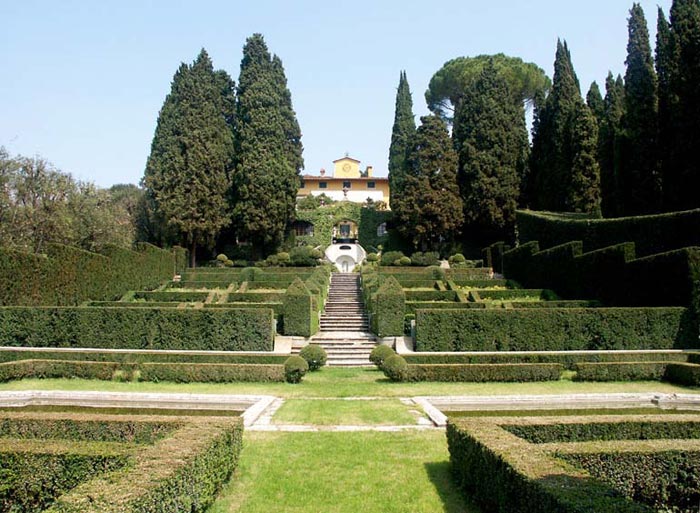 |
||
Villa i Tatti in Settignano, the Villa seen from the bottom of the Italian Garden |
||
| In 1900, the eminent historian and critic of late medieval and Renaissance art, Bernard Berenson, took up residence at Villa I Tatti. He bought the Villa I Tatti in 1905 and (in 1909) commissioned two Englishmen (Cecil Ross Pinsent and Geoffrey Scott) to re-design the garden. Scott was famous as the author of a book on The Architecture of Humanism. Pinsent was a young and unknown architect. They began work at a time when Arts and Crafts designers, inspired by Blomfield, Sedding and others, were filled with enthusiasm for Italian renaissance gardens.The results of their work has many renaissance features, and a friendly pastiche charm, but it does not have the disciplined 'feel' of a genuine renaissance garden. It is now owned by Harvard University and they have a very restrictive policy regarding garden photography. From May 1909 Pinsent commenced practice in Florence, sharing a flat with Scott at the top of an old palazzo in the Via delle Terme. The commission for I Tatti, which Scott had obtained from Berenson, was their fmt important joint undertaking. The villa, which was in a desolate state, lacked formal gardens, arid these were laid out in a succession of terraces on the sloping grOund to the south. Immediately below the house, and occupying its full width, is a parterre, boldly designed in box, below which is the limonaia, with a central archway through which the main garden is revealed, an intricate green cascade of clipped box, descending in tiers, each with its own geometrical pattern. The surviving documentation suggests that, while Pinsent was certainly the maitre d’oeuvre for this job, he had to contend with patrons who had some very clear ideas about what they wanted their garden to look like. Both Mary Berenson and Bernard did not fail to ask their architect for some very substantial modifications to his original project, which intervention was all the more understandable as this was Pinsent’s first major commission. These modifications were often motivated, quite simply, by a wish to curtail expenses (as happened with the proposal for an elaborate staircase from the limonaia to the Italian garden), but in other cases they were motivated by more stylistic considerations. |
||
Villa Medici in Fiesole |
||
 |
||
Villa Medici in Fiesole, Firenze |
||
| The Villa Medici is a patrician villa in Fiesole, Tuscany, Italy, the fourth oldest of the villas built by the Medici family. It was built between 1451 and 1457. The villa owes its fame to Lorenzo il Magnifico who inherited the property in 1469 following the untimely death of his brother. The new master of the house turned the residence into a gathering place for artists, philosophers and men of letters such as Marsilio Ficino, Pico della Mirandola and Poliziano. The quadrangular building is a typical example of the 15th-century edifice, with square serena stone windows and broad loggias looking out over the surroundings. The villa remained the property of the Medici until 1671. It subsequently changed hands several times, and in 1772 was sold to Lady Orford, the sister-in-law of Horace Walpole. In the 19th century it was owned by the artist William Blundell Spence and in 1911 was purchased by Lady Sybil Cutting, wife of the writer Geoffrey Scott. The entrance, which used to be on the Via Vecchia Fiesolana, was moved by Lady Orford in 1772 onto what is now Via Beato Angelico, a change which altered the entire organisation of the villa. At the same time a lemon house was built to a design by Niccolò Maria Gaspare Paoletti. The geographical position of the villa on gently sloping land suggested the layout of the garden on three terraces. The first of these, at the end of an avenue lined with cypress trees that runs underneath a holm-oak wood, has large rectangular lawns with potted lemon trees. The villa's piano nobile looks out onto this part of the garden. The second terrace is overlooked by the rear of the building and is reached by an indoor staircase. This, the least heavily altered part of the garden, has flower beds lined with box hedges with a large fountain in the centre, and is laid out in the shade of large magnolia trees. The third terrace, created between 1911 and 1923 by Cecil Pinsent and Geoffrey Scott is aligned longitudinally with the first, but is 11-12 m lower down. [2] It is laid out in the Italian style, with a fine pergola positioned mid-way between the two levels. Below the lemon garden is an unpaved walk which leads to the pergola which runs the length of another retaining wall. The pergola walks leads to the western terrace and the giardino segreto, or "secret garden." This garden is only accessible by this pergola walk, or through the Villa itself. The giardino segreto has trapezoidal form and consists of four lawn spaces surrounded by box hedges. The garden also has magnolia and lemon trees and a central elliptical pond. In 1918, Lady Sybil Cutting married the architectural historian Geoffrey Scott. Gardens in Tuscany | Villa Medici in Fiesole, Firenze |
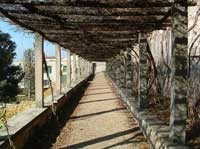 The lowest terrace of Villa Medici is accessible from the pergola walk and is enclosed on three sides with a southern view of Florence.  Domenico Ghirlandaio's fresco in the Tornabuoni chapel, Florence |
|
Villa La Foce |
||
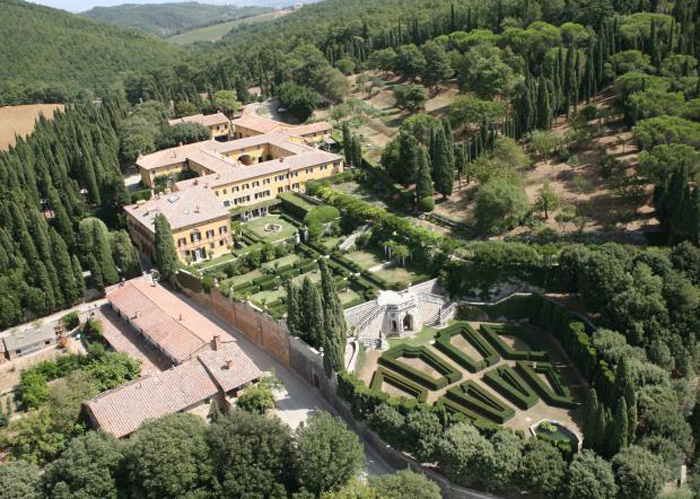 |
||
Villa La Foce estate |
||
Villa La Foce is the main house on the property, consisting today of almost 1200 acres of farmland several farmhouses. It was originally built at the end of the 15th century as a wayside tavern, but soon became the center of an estate belonging to the great Hospital of Santa Maria della Scala in Siena. In 1924 it was purchased by Antonio and Iris Origo, and turned it into their comfortable home, from where they farmed and developed the land. Gardens in Tuscany | Villa La Foce |
|
|
The La Foce Cypress Lined Road. The trees on this road were planted by Iris Origo and Cecil Pinsent to make a nice view from her house and gardens. |
||
Villa Capponi |
||
| Built in the 15th century and most recently the Florentine residence of the Queen Mother of England, Villa Capponi boasts beautiful terraces of green with breathtaking views of Florence, secret gardens with hanging ancient wisteria and a fine stone lily-pool. Shortly after their marriage in 1928, Henry and Esther Clifford, bought the Villa Capponi. The house, with its famous gardens and stunning view of Florence from the hills of Arcetri, had earlier been owned by Charles Perkins, a Boston art historian, and later by Lady Scott, grandmother of Elizabeth Bowes-Lyon, the future queen of George VI of England. The garden, commented upon by Edith Wharton and Geoffrey Jellicoe, dates from the seventeenth century. It was extended by Lady Elizabeth Scott after 1882 and by Charles Pinsent after 1939. Surrounded by steep slopes of vineyards and olive groves, it has that Tuscan combination of architectural refinement within an ordered agricultural setting which exudes an air of dignity and domestic repose. |
||
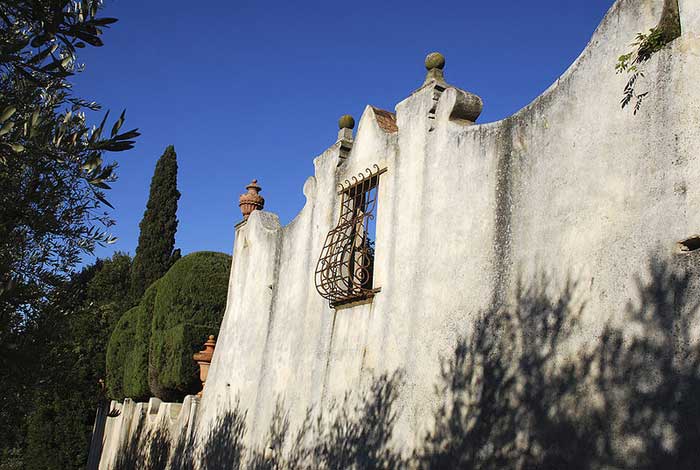 |
||
Villa Capponi - West Garden Wall |
||
| Villa Capponi, built in the 14th century, was purchased in 1572 by the Capponi family which extended it and enhanced it, turning it into a noble residence. In 1882 it became the property of Lady Scott, daughter of the Duke of Portland, and later passed into the hands of the Clifford family. The building, which is quite simple in layout, was further embellished at the end of the 19th century with the additions of two panoramic loggias, the columns for which were, it seems, taken from demolition work done during the redevelopment of the old city centre to create Piazza della Repubblica. The garden, which comprises terraces on different levels, extends along the Pian dei Giullari hillside, from where the view over Florence is quite breathtaking, and blends in with the surrounding farmland. The first terrace, immediately behind the villa, is a broad grassy area stretching the length of the northern side of the building, on which an ancient wisteria hangs. To the east, on the same level, is the entrance to a delightful secret garden, rectangular in layout and edged in box hedges. Access to this formal garden, separated from the lawn by another box hedge, is marked by two columns surmounted by two terracotta griffins. To the west, on different levels, are another two secret gardens with box-edged parterres and surrounded by high walls with elegantly curving crenellations and earthenware urns. The first of these gardens, which lies five metres lower than the level of the villa, is reached by a narrow flight of steps beside the boundary wall. A wrought-iron gate leads to the second garden, at the centre of which stands a fine stone lily-pool. The recently-built rectangular swimming pool lower down is surrounded by tall rows of cypresses. Address - Pian dei Giullari, 4, Firenze. |
||
Villa Le Balze |
||
| Villa Le Balze was planned in 1911 for American Philospher Charles Augustus Strong by Cecil Pinsent. It's name is appropriate as Balze, Italian for cliffs. This long narrow Villa was built in the tight space behind the Villa Medici – also enjoying it’s amazing views. |
||
|
||
Villa Le Balze |
||
| In 1909, Berenson's old Harvard friend, the philosopher Charles Strong, came for a visit and ended up staying. Following Berenson's lead, he commissioned Pinsent to turn a narrow, vertiginous strip of agricultural land in Fiesole into an elegant villa and garden, now called Le Balze. Here Pinsent created a series of garden rooms round a modest Palladian villa, balancing open and closed spaces, short and long axes, vertical and horizontal enclosures. With its dark, mysterious grotto cut into the hillside behind and its dramatic 190 degree terrace overlooking Florence in front, many believe this is Pinsent's most successful design. Villa Le Balze is located in Fiesole, a hilltown overlooking Florence. It was designed for Charles Augustus Strong by two English architects—Geoffrey Scott and Cecil Pinsent. The construction of the Villa extended over two years and was completed in 1913. Le Balze was later integrated with a contiguous property when Strong acquired the Villino in 1919. The Villa rests on three acres of land with three formal gardens, a bosco, and olive groves on the hillside beneath the building. Charles Augustus Strong, who was married to John D. Rockefeller’s oldest daughter Elizabeth, built the Villa (with a legacy from his father-in-law) after his wife’s death in 1905, and he lived there for the rest of his life. Although a reclusive man, he knew Bernard and Mary Berenson, Sibyl Cutting (the mother of Iris Origo) who lived across the street in the Villa Medici, Vernon Lee, Edith Wharton, Elizabeth von Arnim, Bertrand Russell (who visited the Villa in the 1930’s) and George Santayana (a lifelong friend from Harvard). Strong was a philosopher, who studied at Harvard under William James, and he devoted his life to philosophical inquiry. He died at the Villa San Girolomo, just up the road from Le Balze, in the care of the Blue Nuns, in 1940. Address - Via Vecchia Fiesolana, 26, Fiesole (FI) Opening times - The gardens are open for scheduled visits Monday through Friday between 9 a.m. – 12:30 p.m. (last morning entrance 12:00) and 2 p.m. – 4 p.m. (last afternoon entrance 3:30). No visits can be arranged for Saturdays and Sundays, school or public holidays or between end July – end August |
||
Cecil Pinsent and his gardens in Tuscany. Edited by M. Fantoni, H. Flores and J. Pfordresher. Edifir, Florence 1999. ISBN 8879700790. Villa La Foce Estate | La Foce - 61, Strada della Vittoria -53042 Chianciano Terme - Siena | www.lafoce.com Richard Maxwell Dunn, Geoffrey Scott and the Berenson Circle: Literary and Aesthetic Life in the Early 20th Century, Edwin Mellen Press, 1998, ISBN 088946927X, 9780889469273 |
||||
[1] 1891 Census of Hampstead, RG12/108, Folio 25, Page 43, Cecil R. Pinsent, 16, Moresfield Gardens, Hampstead, London. |
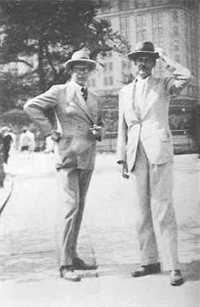 Geoffrey Scott and Cecil Pinsent in Battery Park, New York, August 1929. [Courtesy of Dr John Scott] |
|||
This article incorporates material from the Wikipedia article Cecil Pinsent published under the GNU Free Documentation License.
|
||||
|
||||
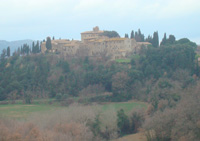 |
||||
Podere Santa Pia |
Podere Santa Pia, view from the garden on the valley below |
Castel Porrona, a charming medieval village dating back to the 11th century, between Cinigiano and Castiglioncello Bandini and Podere Santa Pia | ||
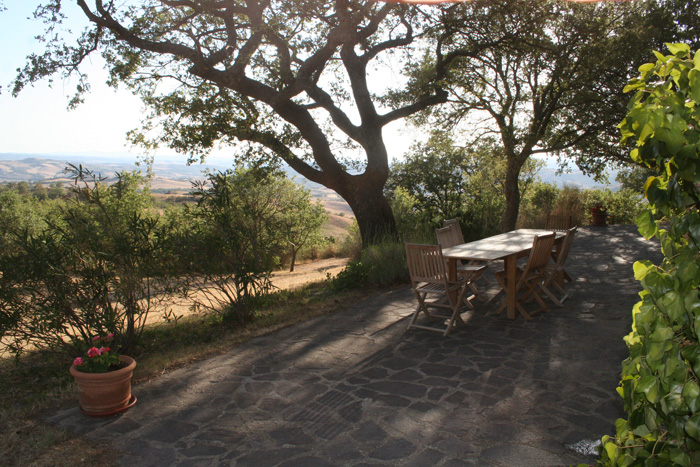 |
||||
Podere Santa Pia, morning view on the Maremma from the southern terrace |
||||

